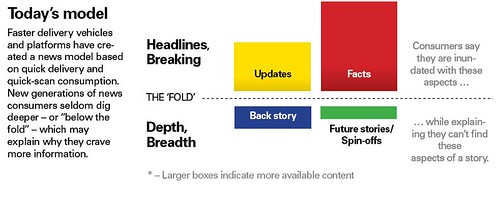Right after lunch at the World Editors Forum, Timothy Balding, Chief Executive Officer of WAN gave us an update of the trends in the newspaper industry. His message was clear, the printed newspaper is far from dead. Global paid circulation for newspapers is up by 2.57% in one year and up 9.39% in five years. The total number of paid printed daily newspapers is up by 2.98% and there is now a total of 11,684 paid titles. About the common statement that the printed newspaper is dead, Balding concluded that “the figures don’t match it.”
But like Roy Greenslade of the Guardian noted, the following session painted a somewhat different picture. “We are living on borrowed time”, said Christof Pleitgen, Reuters. The session included an international consumer study by the Associated Press (pdf here). The AP studied how 18-34 year olds around the globe consume news and found that news publishers need a new model. Some conclusions:
– News is connected to email. “I get my news when I check my e-mail,” was the most often heard response in reference to when people get their news.
– Constant checking is linked to boredom. After e-mail, participants in the study said they checked updates and headlines as a way to pass time and break boredom.
– Contemporary lifestyles impact news consumption. People are sharing information within the home and outside. People sitting with their laptop at home may look antisocial, but they are sharing.
– Consumers want depth but aren’t getting it.– News is multitasked. As part of other activities. News is secondary, not prioritized.
– Consumers are experiencing news fatigue.
– Television impacts consumers expectations. You cant get away from tv. Tv represents a certain delivery of news that people are used to.
– Story resolution is key. Sports and entertainment deliver on that (these stories have a beginning and an end). News do not do that.
– News takes work today. But it creates social currency. Young media consumers have to work to get their news. They are the ones that need to create the value.
Jim Kennedy, Associated Press and Robbie Blinkoff, Context-Based Research Group talked about how the old media model – the inverted pyramid – has been undone. Now people are consuming news across platforms and brands. So media need to deliver appealing content, designed to satisfy all four news needs in the consumption model (Facts, Updates, Back Story, Future Story) and then deliver it across all the channels.
Anthropologist’s (Blinkoff) recommendations to media:
– Deliver depth.
– Address news fatigue and balance. Need to reduce the repetition. Don’t serve us headlines, we have already read that.
– Create social currency. Which piece of what I am about the produce is easy to share? News you can use by sharing.
The new model:
